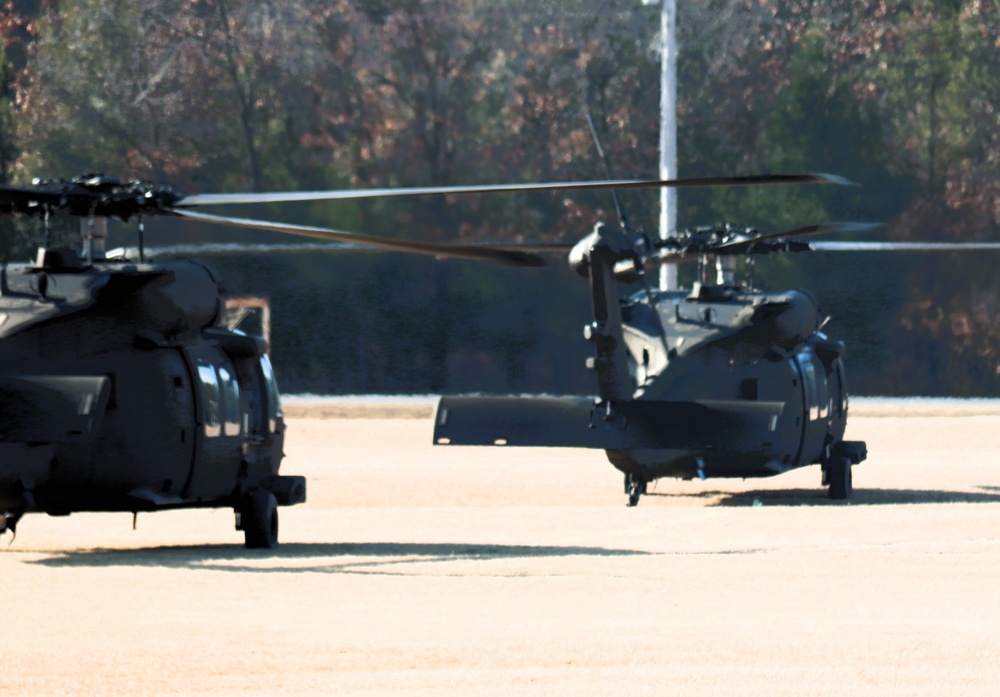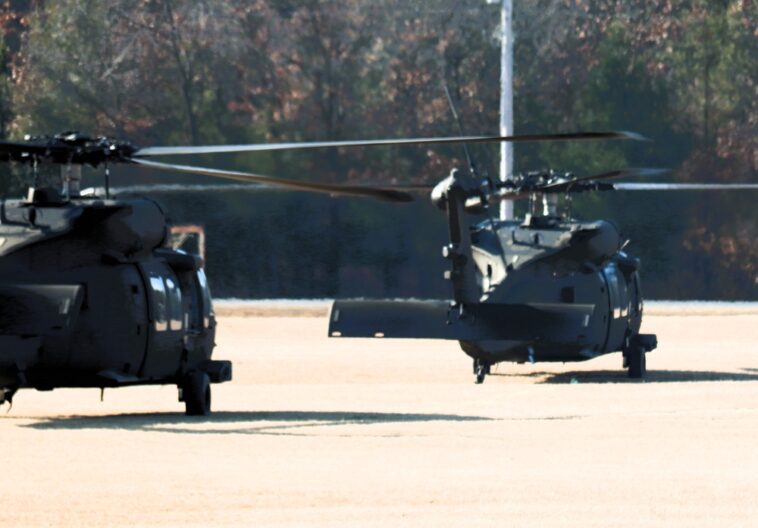
Military Readiness and the Role of Modern Aviation in National Security
The recent maintenance window announcement and the accompanying report on the Wisconsin National Guard’s UH-60 Black Hawk operations at Fort McCoy have once again underscored the importance of maintaining a robust and agile military force. In these times of rapidly evolving threats and shifts in defense priorities, the role that modern aviation assets play has become more critical than ever. This opinion piece explores the multifaceted aspects of military readiness, the legal and policy implications of defense operations, and the impact of innovative training exercises on our national security posture.
At the heart of this discussion is the recent competition event held by the 181st Multi-Functional Training Brigade (MFTB). The event, which featured a series of physically and mentally challenging exercises, showcased not only the tactical prowess of our soldiers but also the performance capabilities of advanced aircraft like the UH-60 Black Hawk. As observers, it is important to ponder the legal, operational, and strategic dimensions that such events bring to the broader defense strategy.
Supporting National Guard Operations: Legal and Policy Perspectives
National security and defense operations are inherently tied to a complex legal framework that governs the use of state and federal military assets. The integration of advanced technology into training events, such as the utilization of Black Hawk helicopters in maneuver competitions, raises a number of legal questions regarding procurement, operational oversight, and accountability.
Legal Considerations in Military Asset Utilization
Using the UH-60 Black Hawk in multiple training environments demonstrates a proactive approach towards enhancing military mobility and operational readiness. However, this strategy also brings with it some tricky parts, including:
- Compliance with Federal Regulations: Every utilization of such assets must align with federal regulations governing procurement, maintenance, and deployment. There are hidden complexities in ensuring that all steps of maintenance, documentation, and use are recorded in accordance with law.
- State Versus Federal Control: The National Guard operates under a dual state-federal command structure. Balancing the responsibilities between state-specific directives and national security requirements often involves working through some confusing bits in policy and oversight.
- Liability and Accountability: Any misstep in operations not only puts service members at risk but can also lead to legal challenges. Ensuring that all parties involved in training exercises understand their roles mitigates the risk of legal action.
In order to frame these issues correctly, legal experts must dig into the fine points of these regulations and develop best practices that allow for flexibility during training while maintaining adherence to strict legal guidelines.
Policy Implications of Advanced Technology Integration
The integration of new technology and enhanced aviation capabilities has been a key component of the U.S. Army’s modernization plan. With over 9 million total fleet hours accumulated by Black Hawk helicopters, the evolution of these machines is a testament to decades of refinement and technical improvement. Yet, the success of such technology is dependent on a framework that is super important for long-term strategic planning. Some points to consider include:
- Budgetary Considerations: The acquisition and maintenance of technology like the improved turbine engine and airframe upgrades are tasks that require significant investment. Decision-makers must steer through financial constraints while ensuring that technological advances are prioritized.
- Regulatory Adaptations: As newer versions of these aviation assets enter service, regulatory bodies must take into account the subtle details of upgraded equipment. The fine shades distinguishing the newer models from their predecessors can sometimes be nerve-racking for regulators required to update standards and requirements.
- Improved Safety Standards: Legal responsibilities do not end at procurement. The ongoing duty to implement enhanced safety measures for both aircrew and passengers is central to the operational life of these helicopters. Integrating improvements like crash-worthiness and composite materials requires all stakeholders to work together to create guidelines that are both practical and compliant with modern safety regulations.
Overall, modern defense operations are not just about enhancing military might but also about ensuring that the legal scaffolding is robust, transparent, and adaptive to change.
The Strategic Value of Training Exercises at Fort McCoy
The 181st MFTB competition at Fort McCoy serves as an excellent case study for how training exercises contribute to national security objectives. Designed to test both mental and physical endurance, competitions like these reflect the twisting turns of military preparation, where every challenge provides an opportunity to assess and improve tactical readiness.
Multifaceted Challenges: Physical and Tactical Endurance
The competition comprised several physical exercise challenges, starting with early morning endurance drills that set the stage for the day’s rigorous agenda. By taking part in these physically demanding tasks, competitors showcased their ability to manage nerve-racking situations and complicated pieces of training concurrently. Some of the appreciated areas include:
- Physical Endurance Drills: These challenges require participants to overcome intimidating physical obstacles, testing their stamina and resilience under pressure.
- Field Exercises: Transitioning from controlled environments to unpredictable training fields involves sorting through both planned procedures and unexpected variables that may be loaded with issues.
- Specialized Training Lanes: The exercises include tests that simulate chemical, biological, radiological, and nuclear (CBRN) threats, grenade lanes, and stress shooting drills. These tasks not only push physical limits but also bring participants face-to-face with confusing bits of simulated combat situations, adding extra layers of necessity for precise legal and operational protocols.
Each exercise is a critical component in the broader strategy of preparing soldiers for real-life conflict situations. When military personnel demonstrate exceptional performance, highlighted by teams taking top positions in such competitions, it reinforces the message that continuous improvement is key to national defense.
Advanced Tactical Operations: The Role of UH-60 Black Hawk Helicopters
The inclusion of UH-60 Black Hawks in training operations, particularly in challenging tasks like ferrying troops during the competition, illustrates the indispensable role that modern aviation plays in military strategies. The Black Hawk is not just a utility helicopter—it is a multipurpose asset capable of air assault, aeromedical evacuation, command and control, and support for special operations. Its ability to get around within multiple contexts reflects its versatility, further enhanced by decades of technological improvements.
This operational flexibility can be summarized as follows:
| Mission Feature | Capability |
|---|---|
| Air Assault | Rapid deployment of forces in contested environments |
| Aeromedical Evacuation | Quick and efficient medical evacuation from combat zones |
| Command and Control | Integrated communication systems for battlefield management |
| Special Operations Support | Enhanced mobility and versatility during covert missions |
The table above captures the nuanced details of what makes these helicopters a must-have asset. Their design improvements over the years—such as better troop seating and lighter composite tails—demonstrate a consistent commitment to refining performance in ways that are both practical and compliant with safety regulations.
Modernization and Legal Implications in Defense Technology
The United States military has always prided itself on being at the forefront of technological development. As seen with the evolution of the Black Hawk helicopters, the ongoing upgrades represent the Army’s efforts to stay agile in a landscape that is full of problems and quickly evolving risks. Modernization efforts in defense technology come with a set of tricky parts and legal challenges that merit closer examination.
Research and Development: Balancing Innovation with Regulation
Innovation in defense technology is a balancing act that requires careful assessments of potential benefits and legal constraints. In many ways, research and development in this field is akin to working through complicated pieces of a puzzle where every tiny piece must fit perfectly into a broader strategy. Key factors to consider include:
- Intellectual Property Issues: As defense contractors design and refine new technologies, the protection of intellectual property is a key legal consideration. Companies and the government must figure a path that allows for innovation while respecting existing patents and trademarks.
- Compliance with Safety Standards: Upgraded designs, such as the integration of improved turbine engines or enhanced troop seating, require rigorous testing and certification processes governed by both military and civilian regulatory standards.
- Data Security and Cyber Concerns: With modern systems increasingly connected, the secure transmission of data during operations is essential. Recent cybersecurity incidents have shown how quickly shaken these systems can be, making the establishment of secure protocols a super important legal requirement.
In this realm, legal experts must not only assess the potential military advantages but also ensure that every new piece of equipment or software adheres to a strict regulatory framework. This challenge is filled with baffling twists and turns that call for ongoing dialogue among stakeholders including policymakers, scientists, and attorneys.
Integration Challenges: Addressing the Hidden Complexities of Multinational Standards
Military operations today rarely happen in isolation, and our defense technology must often be integrated within multinational frameworks. The fine points of these integrations include:
- Interoperability: Forces from different allied countries often work side-by-side. The technology used by American forces, therefore, must be designed to communicate and operate effectively with systems from other countries. There are often small distinctions that become significant when aligning protocols and standards across borders.
- Legal Harmonization: When different nations collaborate, ensuring that equipment meets a series of overlapping but sometimes conflicting legal standards is off-putting. Legal teams need to work diligently to sort out issues of sovereignty and international law.
- Contractual Obligations: The procurement of advanced systems involves numerous contracts, each loaded with issues that require precise definition of responsibilities and risk-sharing measures. These legal documents often need to dive in to the subtle details of risk management, safety protocols, and performance benchmarks.
These integration challenges, while intimidating, are addressed through strong international partnerships and dedicated efforts to build interoperable systems. The enhanced cooperation among nations bolsters the strategic position of the United States, ensuring that our military remains agile and adaptable in an increasingly interconnected world.
The Importance of Training and Continuous Improvement
A key takeaway from the Fort McCoy competition is the emphasis on continuous improvement. Training exercises such as these are more than just physical contests; they are critical opportunities for reviewing, testing, and advancing military protocols, procedures, and teamwork.
Enhancing Operational Efficiency Through Realistic Scenarios
Training exercises incorporate real-life scenarios that enable soldiers and support crews to test their readiness under pressure. While realistic simulations often come with intimidating challenge scenarios, they serve as a practical way to evaluate the hidden complexities of crisis management. The benefits include:
- Practical Exposure: Soldiers gain hands-on experience that prepares them to handle actual combat situations. This exposure is essential for bridging the gap between training environments and the unpredictable nature of real-world operations.
- Team Coordination: Such events provide a platform for units to figure a path through coordination challenges, ensuring every individual understands their role within the larger mission framework.
- Feedback and Assessment: Post-training assessments and debriefings offer an opportunity to review performances and identify areas where improvements are needed. This iterative process is key to refining methodologies and enhancing overall mission success rates.
When troops take part in multifaceted exercises ranging from stress shooting to simulating CBRN threats, the entire military apparatus benefits from fresh insights on how to work through both expected and unexpected issues. In essence, continued training is a must-have component of an effective military strategy.
Modern Training Facilities: The Strategic Role of Fort McCoy
Fort McCoy stands out as a remarkable example of a modern training center that supports thousands of military personnel each year. Its status as the “Total Force Training Center” is not merely a slogan but a testament to the facility’s critical role in shaping operational readiness. Key elements of Fort McCoy’s ongoing success include:
- State-of-the-Art Infrastructure: Fort McCoy hosts both field and classroom training, providing an environment where theoretical knowledge can be immediately applied in practical scenarios.
- Continuous Support for Innovation: The facility is continuously upgrading its training capabilities to include the latest in simulation technology, ensuring that soldiers face scenarios that mirror modern battlefields.
- Accessibility and Community Integration: As the only U.S. Army installation in Wisconsin, it plays an important role in fostering a sense of community among military personnel while ensuring that local states are active participants in national defense.
For military personnel, facilities like Fort McCoy are more than just training grounds—they are the proving grounds where theory meets practice. Here, soldiers have the chance to figure a path through nerve-racking exercises that mimic the real challenges they might face in operations worldwide.
Legal and Ethical Dimensions of Military Operations
Beyond operational efficiency, it is important to consider the legal and ethical dimensions of military operations that are highlighted during such training exercises. Upholding high ethical standards and strict legal accountability becomes all the more important in a landscape that is full of problems and unpredictable developments.
Ethical Considerations in the Use of Force and Technology
The ethical deployment of technology such as the UH-60 Black Hawk must be underpinned by rigorous best practices. Some of the key aspects to consider include:
- Respecting Human Life: Above all, the use of any military technology—no matter how advanced—must prioritize the preservation of human life. Training sessions are designed to prepare service members to handle situations with the utmost care and responsibility.
- Transparency and Accountability: Transparency in how resources are deployed and accountability for their use are essential for maintaining public trust. When training exercises are conducted in an open and monitored environment, it helps establish a clear chain of command and responsibility.
- Adherence to International Laws: Training and operational procedures must align with international standards and treaties regarding the conduct of military operations. This requires legal experts and military strategists to work closely together to ensure that every decision is above board and defensible.
These ethical imperatives ensure that as the military continues to modernize its forces, it does so without compromising the core values that serve as the backbone of national security policy.
Legal Accountability in Training and Operational Readiness
Legal accountability plays a key role in reinforcing operational discipline. During multifaceted training events, the emphasis on upholding ethical principles is matched by the need for legal transparency. Notable areas of focus include:
- Incident Documentation and Review: Every training exercise is thoroughly documented, ensuring that any issues that arise are analyzed in detail. This accountability helps in addressing any tangled issues or small distinctions that may appear during these events.
- Regulatory Compliance Audits: Regular audits ensure that every operational detail, from aircraft maintenance to training protocols, complies with established legal standards and procedures.
- Post-Exercise Debriefs: These sessions allow military leadership to take a closer look at what worked and what didn’t. Such feedback loops are essential for continual improvement and for ensuring that any unintended lapses are quickly addressed.
The legal framework surrounding military operations must be robust enough to support both innovation and accountability. The challenges remain intimidating at times, but effective oversight and continuous improvement ensure that operational integrity is maintained.
Future Outlook: Balancing Tradition and Innovation
As we move further into the 21st century, the defense landscape is evolving at a pace that is both exciting and challenging. The experience at Fort McCoy and the exemplary performance of the Black Hawk helicopters are a reminder that tradition and modern innovation can coexist in a mutually beneficial way. However, balancing these two elements involves working through some complicated pieces and critical decisions.
Preserving Proven Strategies While Embracing New Technologies
Historically, military success has been built on the foundation of time-tested strategies. Yet, the integration of new technologies presents both opportunities and tricky parts that policymakers must manage carefully. Consider the following factors:
- Historical Doctrine Versus Modern Tactics: While age-old strategies have laid the groundwork for our military’s ethos, modern technology offers new avenues to enhance these tactics. The challenge is to find a path that respects the legacy of past successes while incorporating fresh, innovative approaches.
- Incremental Innovation: The evolution of the Black Hawk helicopter is an excellent manifestation of how iterative improvements can lead to significant performance gains. Agility in decision-making is essential as mixed methodologies that blend old and new approaches are developed.
- Training and Doctrine Integration: Continuous training exercises must integrate cutting-edge technology into their curriculum, ensuring that service members are well-prepared for modern challenges. This requires a readjustment of traditional training protocols to include modules focused on digital warfare and unmanned systems.
In this context, it becomes clear that military strategy must not rest on old laurels. Instead, it must dynamically adapt to the changing character of warfare and embrace both legacy wisdom and technological breakthroughs.
Policy Reform and Future Challenges
Looking forward, policymakers and military leaders face an array of nerve-racking decisions as they work to secure the future of our national defense. Some pivotal issues include:
- Enhanced Interagency Collaboration: Strengthening the communication channels between different branches of the military, as well as between national and state-level organizations, is key. This collaboration ensures that tactical decisions consider both legal ramifications and operational efficiency.
- Up-to-Date Regulatory Frameworks: It is essential for legislative bodies to update regulations to keep pace with technological advancements. This work involves untangling regulations that may be outdated and creating policies that are flexible enough to accommodate rapid innovation.
- Investments in Human Capital: While technology is essential, the human element remains irreplaceable. Continuous professional development and training for military personnel, along with focused legal studies, are critical to ensuring that our forces can manage the complicated pieces of modern warfare effectively.
Policy reform that takes into account fine shades of legal and operational needs will be crucial. The balancing act is challenging, but with clear-eyed vision and detailed planning, our national security apparatus can continue to grow stronger and more resilient.
Lessons Learned from the 181st MFTB Competition
The Fort McCoy event has provided plenty of food for thought, not just for tactical analysts and military experts but also for legal scholars and policymakers tasked with shaping our defense strategy for the future. Several key lessons emerge from the competition:
Recognition of Excellence in Military Training
The competition saw teams and individuals who excelled under intense pressure, such as Capt. Daniel Logan, Staff Sgt. David Fitzpatrick, Capt. Drew Russel, and Sgt. 1st Class Logan Krul, who advanced to further competitions. This acknowledgment of excellence not only boosts morale but also highlights the importance of continuous, realistic training. The ways in which these service members adapted to nerve-racking scenarios provide actionable insights:
- Emphasis on Teamwork: The competition underscored that cohesive teamwork is a must-have element. Teams that work in unison are better equipped to handle unpredictable challenges.
- Resilience Under Pressure: Competitors faced physically challenging drills and mentally overwhelming obstacles, reaffirming that resilience is built through repetitive and realistic training scenarios.
- Commitment to Continuous Improvement: Every exercise serves as a learning opportunity. The documented feedback and after-action reviews offer valuable lessons crucial for making necessary adjustments in both tactics and legal compliance.
This recognition of excellence raises several important questions about the continual evolution of military training programs. Expectations for performance are high, and the legal framework must evolve to both support and scrutinize these standards.
Operational Flexibility and Future Preparedness
The innovative approach taken at Fort McCoy is a model for how modern military operations can foster a culture of forward-thinking and adaptability. The operational flexibility demonstrated by the Black Hawk helicopters—flying troops, supporting field operations, and coordinating complex maneuvers—exemplifies how technology and human capability can blend seamlessly. Some visible takeaways include:
- Multi-Dimensional Training: Incorporating scenarios ranging from chemical threat simulations to stress shooting drills prepares service members for an array of challenges.
- Dynamic Resource Allocation: The efficient use of assets like the UH-60 Black Hawk illustrates how strategic resource allocation can maximize readiness while adhering to legal and regulatory standards.
- Bridging Technological Advances and Human Skill: As we incorporate more technology into training, the fine shades distinguishing technical proficiency and human ingenuity become more evident. Effective training embraces both, ensuring each element reinforces the other.
The operational flexibility shown in these exercises is reflective of a broader trend: preparedness for today’s unpredictable security environment demands that military forces become more agile, adaptive, and legally accountable.
Conclusion: Charting a Responsible Path Forward
Few sectors today are as heavily scrutinized as the military, where operational readiness, legal strictures, and technological innovation intersect in ways that are often tangled with issues and nerve-racking challenges. The events at Fort McCoy—combined with the strategic role of the UH-60 Black Hawk—serve as tangible proof that modern defense operations rely on a delicate balance between tradition and innovation. They remind all stakeholders—from policymakers and legal experts to servicemen and women—that continuous improvement, accountability, and adaptability are essential ingredients for national security.
The maintenance window and the subsequent training events, when viewed through the lens of legal and operational perspectives, depict a landscape where every decision made resonates through the halls of national defense. Amid daunting challenges and the constant need for rigorous oversight, our military continues to hone its capabilities, ensuring that every training session builds a stronger, more reliable force capable of protecting the nation.
As we look to the future, it will be super important to integrate emerging technologies in a manner that respects both historical doctrine and the new digital era. This effort involves untangling complicated pieces of legislation, updating regulatory frameworks, and continuously investing in personnel who are equipped to face the rigorous demands of modern warfare.
It is through such detailed and persistent endeavors that our military remains prepared for whatever challenges lie ahead. The competitive spirit demonstrated at Fort McCoy reflects a broader commitment to excellence that, despite being full of problems at times, is steadily driving our force toward unprecedented levels of readiness and operational agility.
In conclusion, balancing legal obligations with the need for rapid innovation in our defense sector is not just an operational necessity—it is a cornerstone of our national security. The experiences documented in recent training competitions serve as inspiration for future developments and as a call to action: that every twist and turn of military preparedness should be matched with a commitment to legal accountability and responsible technological modernization.
As the military continues to work through challenging operations, policymakers, military strategists, and legal experts must all find their way through this intricate landscape. With open dialogue, thoughtfully crafted regulations, and a focus on continuous improvement, the path forward, although occasionally intimidating and off-putting, is certainly navigable. Our nation’s future security hinges on how well we manage these small distinctions and fine details, ensuring that every legal and operational challenge is met with a coordinated, forward-thinking response.
The combined efforts of training centers like Fort McCoy, the innovative advancements in military aviation, and the meticulously developed legal framework represent a blueprint for success—a strategy that is as much about human resilience as it is about technological prowess. This dual focus ensures that our armed forces remain ready not only to defend our borders but also to uphold the principles of law and order that are the bedrock of our society.
Ultimately, the experiences shared by the National Guard and the performance of the Black Hawk helicopters in competitive training scenarios highlight a clear message: continuous development, rigorous oversight, and a progressive mindset are the keys to a secure and sustainable future. By embracing both modern technology and sound legal practices, our military is well-equipped to address the nerve-racking challenges of tomorrow, making each victory on the training field a testament to the enduring spirit of national defense.
Originally Post From https://www.dvidshub.net/news/493750/wisconsin-national-guard-uh-60-black-hawks-crews-support-181st-mftb-competition
Read more about this topic at
Introductory Demo Flights in Los Angeles
Heli Expo showcases new turbine helicopter training tech


